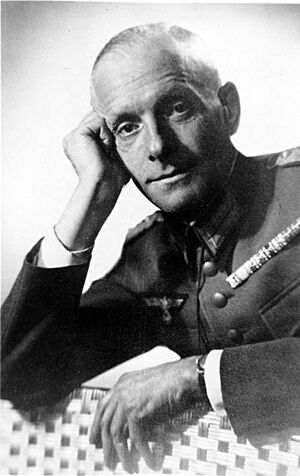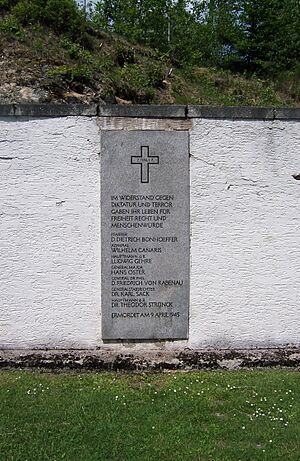Hans Oster facts for kids
Quick facts for kids
Hans Oster
|
|
|---|---|

Oster in 1939
|
|
| Deputy Chief of the Abwehr | |
| In office 1935 – 21 July 1944 |
|
| Leader | Wilhelm Canaris |
| Personal details | |
| Born |
Hans Paul Oster
9 August 1887 Dresden, German Empire |
| Died | 9 April 1945 (aged 57) Flossenbürg concentration camp, Nazi Germany |
| Cause of death | Execution by hanging |
| Military service | |
| Allegiance | |
| Branch/service |
|
| Years of service |
|
| Rank | |
| Battles/wars | World War I
World War II |
Hans Paul Oster (born August 9, 1887 – died April 9, 1945) was a German general. He became a very important person in the German resistance movement against Adolf Hitler and the Nazis.
From 1938 to 1943, Oster was the deputy head of the Abwehr. This was Germany's military intelligence (spy) agency. His job allowed him to secretly work against the Nazi government.
He was involved in a plan called the Oster conspiracy in September 1938. In 1943, he was arrested. This happened because he was suspected of helping Abwehr officers who were helping Jewish people escape Germany. After the failed July Plot to kill Hitler in 1944, Oster was questioned. He named Wilhelm Canaris, the head of Abwehr, as a leader of the resistance. The Gestapo (Nazi secret police) found Canaris's diaries. These diaries showed Oster's anti-Nazi actions. In April 1945, Oster was executed along with Canaris and Dietrich Bonhoeffer at Flossenbürg concentration camp.
Early Life and Military Career
Hans Oster was born in Dresden, Germany, in 1887. His father was a pastor. In 1907, Oster joined the artillery. During World War I, he fought on the Western Front until 1916. He then became a captain in the German General Staff.
After the war, he stayed in the German army, called the Reichswehr. The Treaty of Versailles limited the number of officers in this army to 4,000. In 1932, Oster had to leave the army for a short time due to a personal matter.
He soon found a new job in a police organization. In October 1933, he moved to the Abwehr. There, he met Hans Bernd Gisevius and Arthur Nebe. These men worked for the Gestapo and later joined the secret resistance. Oster also became a close friend of Admiral Canaris.
Standing Up to Adolf Hitler
At first, Oster, like many other army officers, welcomed the Nazi government. However, his feelings changed after 1934. This was when the "Night of the Long Knives" happened. During this event, the Schutzstaffel (SS) killed many rivals and political opponents. Among them were General Kurt von Schleicher and Generalmajor Ferdinand von Bredow.
By 1938, events like the Blomberg–Fritsch Affair and Kristallnacht made Oster hate Nazism. Kristallnacht was a terrible night when Nazis attacked Jewish people and their businesses. Oster then decided to help save Jewish people. During the Fritsch crisis, Oster met Generaloberst Ludwig Beck. Beck was the Chief of the General Staff. This meeting helped set up the Oster conspiracy in September 1938.
Oster's job in the Abwehr was very helpful for the resistance. The Abwehr could provide fake documents and special materials. It could also make secret activities look like intelligence work. This helped connect different resistance groups. Oster also played a key role in the first military plan to overthrow Hitler. This plan started because Hitler wanted to invade Czechoslovakia.
In August 1938, General Beck openly spoke against a war over Czechoslovakia. When Hitler found out, he demanded Beck's resignation. Beck was highly respected, and his removal shocked the army officers. His replacement, Franz Halder, stayed in touch with Beck and Oster. Halder privately called Hitler "the incarnation of evil."
Oster, Gisevius, and Hjalmar Schacht urged Halder and Beck to plan a coup (a sudden takeover of the government) against Hitler. However, the generals felt they could only get support if Hitler clearly moved towards war. Halder asked Oster to draw up coup plans. They agreed Halder would start the coup when Hitler made an obvious move toward war.
The conspirators sent people to Britain, with Oster's help. They wanted to convince the British to stand firm against Hitler over the Sudeten crisis. But on September 28, the British Prime Minister Neville Chamberlain agreed to a meeting in Munich. There, he accepted the breakup of Czechoslovakia. Hitler's diplomatic success weakened the conspirators.
As war became more likely in mid-1939, the coup plans were revived. Oster was still in contact with Halder. However, many officers were against Poland and thought a war to get back lost eastern lands was fair. After World War II began, resistance became harder. It could lead to Germany's defeat. When Hitler decided to attack France in 1939, Halder and other generals thought it was impossible. They again considered a coup, urged by Oster. When Hitler threatened to destroy "defeatism," Halder feared the plot would be found out. He destroyed all secret documents.
Oster secretly told his friend Bert Sas, a Dutch military official, the date of the postponed invasion of the Netherlands more than twenty times. Sas passed the information to his government, but they did not believe him. Oster knew his actions could cost German soldiers' lives. But he believed it was necessary to prevent millions of deaths in a long war.
Between 1940 and 1942, German resistance was at a low point. Some officers were glad they were wrong about military disaster. Others still opposed Hitler but felt his popularity made action impossible. Oster worked tirelessly to rebuild the resistance network. In 1941, when the systematic killing of European Jews began, his Abwehr group connected with Henning von Tresckow's resistance group. In 1942, Oster recruited General Friedrich Olbricht. Olbricht was head of the General Army Office in Berlin. He controlled a communication system to army units across Germany. Oster's group provided bombs to Tresckow's group for their attempts to kill Hitler in 1943.
In 1943, the Abwehr group's efforts to rescue Jewish people were discovered by the Gestapo. Oster was removed from his job. Hans von Dohnanyi, who joined the Abwehr before the war, and Dietrich Bonhoeffer, a Lutheran religious leader and Dohnanyi's brother-in-law, helped 14 Jewish people escape to Switzerland. They disguised them as Abwehr agents. Dohnanyi and Bonhoeffer were arrested. Oster was placed under house arrest.
Death
Oster was arrested the day after the failed July 20, 1944, plot to kill Hitler. On April 4, 1945, Admiral Canaris's diaries were found. Hitler became furious when he read them. He ordered that all past and present conspirators, including Oster, be executed.
On April 8, 1945, Oster, Dietrich Bonhoeffer, Wilhelm Canaris, and other anti-Nazis were found guilty and sentenced to death by a special SS court. Early the next day, Oster, Bonhoeffer, and Canaris were executed by hanging at the Flossenbürg concentration camp.
Fabian von Schlabrendorff, one of the few senior anti-Nazis who survived the war, described Oster as "a man such as God meant men to be, lucid and serene in mind, imperturbable in danger."
See also
 In Spanish: Hans Oster para niños
In Spanish: Hans Oster para niños
- List of members of the 20 July plot
- Oster Conspiracy


